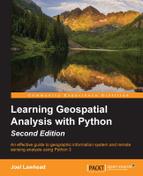Despite dozens of formats, geospatial data have common traits. Understanding these traits can help you approach and understand unfamiliar data formats by identifying the ingredients common to nearly all spatial data. The structure of a given data format is usually driven by its intended use. Some data is optimized for efficient storage or compression, some is optimized for efficient access, some is designed to be lightweight and readable (web formats), while other data formats seek to contain as many different data types as possible.
Interestingly, some of the most popular formats today are also some of the simplest and even lack features found in more capable and sophisticated formats. Ease of use is extremely important to geospatial analysts because so much time is spent integrating data into geographic information systems as well as exchanging data among analysts. Simple data formats facilitate these activities the best.
Geospatial analysis is an approach applying information processing techniques to data with geographic context. This definition contains the most important elements of geospatial data: geolocation data and subject information. These two factors are present in every format that can be considered geospatial data. Another common feature of geospatial data is spatial indexing. Overview datasets are also related to indexing.
Geolocation information can be as simple as a single point on the Earth referencing where a photo was taken. It can also be as complex as a satellite camera engineering model and orbital mechanics information to reconstruct the exact conditions and location under which the satellite captured the image.
Subject information can also cover a wide range of possibilities. Sometimes, the pixels in an image are the data in terms of a visual representation of the ground. At other times, an image may be processed using multispectral bands, such as infrared light, to provide information not visible in the image. Processed images are often classified using a structured color palette that is linked to a key, describing the information each color represents. Other possibilities include some form of database with rows and columns of information for each geolocated feature, such as the population associated with each city in our SimpleGIS from Chapter 1, Learning Geospatial Analysis with Python.
